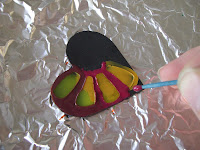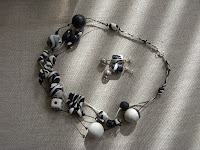
A couple of random things I've done using felt (technique was explained in an earlier entry).


Os dejo aqui un par de fotos con cosas que he hecho con fieltro.
This blog is to explore my creative side specially through jewelry making (which is my latest hobby) but it can also be painting, knitting... I'll include pictures of my designs and brief explanations on how to create them. It's also a bit of a test for me; depending on the results and critics/comments, I might decide to go a bit more commercial with this hobby :)










 a (Diamond Glaze u otro). Dejalo secar en un sitio resguardado ya que cualquier mota de polvo se pegara a la superficie.
a (Diamond Glaze u otro). Dejalo secar en un sitio resguardado ya que cualquier mota de polvo se pegara a la superficie.
 To do this, we'll need a couple of autumn leafs in different sizes and two clay bars in different colors (redish/copperish and green for example). To work the clay you can use a pasta machine or simply your han
To do this, we'll need a couple of autumn leafs in different sizes and two clay bars in different colors (redish/copperish and green for example). To work the clay you can use a pasta machine or simply your han ds (cheaper!).
ds (cheaper!).
 You can now lift the leaf. You can use the clay leftovers to make small beads that y
You can now lift the leaf. You can use the clay leftovers to make small beads that y ou can later combine with the pendant or maybe use to make assorted earrings. (Note: if you don't have a manual drill, you might want to make holes on your pendant and beads before cooking them). Put all of this on an aluminum foil and set it in the middle of the oven (most clays need about 30min at 230F).
ou can later combine with the pendant or maybe use to make assorted earrings. (Note: if you don't have a manual drill, you might want to make holes on your pendant and beads before cooking them). Put all of this on an aluminum foil and set it in the middle of the oven (most clays need about 30min at 230F). Atencion: si no tienes un taladrador manual para agujeros, hazle un agujero al colgante con la ayuda de un palillo de dientes redondeado antes de meterlo en el horno.
Atencion: si no tienes un taladrador manual para agujeros, hazle un agujero al colgante con la ayuda de un palillo de dientes redondeado antes de meterlo en el horno.






 Cogemos unas cuantas mechas de uno de los paquetes de lana; simplemente tirando con suavidad se iran soltando del monton. Los ponemos todos juntos y formamos una pequena bolita con los dedos como se ve en las fotos que siguen:
Cogemos unas cuantas mechas de uno de los paquetes de lana; simplemente tirando con suavidad se iran soltando del monton. Los ponemos todos juntos y formamos una pequena bolita con los dedos como se ve en las fotos que siguen:

 e). La vamos metiendo en el bol de agua cuando sea necesario para eliminar el exceso de jabon. Una vez que la bola sea compacta, la enjaguamos estrujandola para eliminar agua y luego la pasamos por la toalla para ayudar a secar mas rapidamente.
e). La vamos metiendo en el bol de agua cuando sea necesario para eliminar el exceso de jabon. Una vez que la bola sea compacta, la enjaguamos estrujandola para eliminar agua y luego la pasamos por la toalla para ayudar a secar mas rapidamente. o agujeros en las bolitas. A continuacion pasamos la cuerda o cordoncillo por la bolitas y las combinamos con las perlas de colores que teniamos al pricipio. Hacemos nudos en los extremos para que no se salga nada y lo anudamos a la base del pendiente y, voila, unos pendientes divertidos
o agujeros en las bolitas. A continuacion pasamos la cuerda o cordoncillo por la bolitas y las combinamos con las perlas de colores que teniamos al pricipio. Hacemos nudos en los extremos para que no se salga nada y lo anudamos a la base del pendiente y, voila, unos pendientes divertidos , originales y faciles de hacer!!!
, originales y faciles de hacer!!!
 Este conjunto de collar y pendientes esta hecho con cuentas de arcilla de colores; en este caso blanca y negra.
Este conjunto de collar y pendientes esta hecho con cuentas de arcilla de colores; en este caso blanca y negra.


